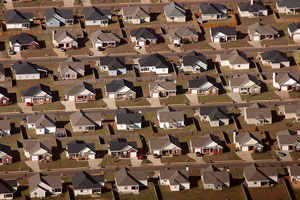
Transportation is the top source of greenhouse gas emissions in California. So in a state where car culture rules, what will it take to get us out of our cars?
That’s the goal behind SB 375, a bill passed in 2008 that links greenhouse gases to urban sprawl. Under this first-in-the-nation policy, the state’s 18 regional planning organizations must reduce the emissions coming from vehicles through land use and transportation planning. This week, the Air Resources Board is expected to release the draft emission reduction targets that the agencies must meet by 2020 and 2035.
While the chances of getting Californians out of their cars completely are slim, the idea is to reduce the number of miles traveled through more public transit, more “walkable” communities and denser development. (Learn more about that in this Quest story about transit villages).
According to a report released today, that development approach can have some dramatic benefits, considering how California is expected to grow. By 2050, some projections put the population at 60 million, adding seven million new households.
The planning firm Calthorpe Associates looked at those housing needs and ran a number of growth scenarios, in a study funded by the California Strategic Growth Council and California High Speed Rail Authority. They compared a business-as-usual approach of low-density suburbs (30% urban and compact growth) to a “growing smart” scenario with more urban in-fill and transit-oriented development (90% urban and compact growth). While that last scenario may sound like the land of endless condos, according to Peter Calthorpe, it would still be 53% single family homes. Calthorpe calls it “a shift back to what California used to build–bungalows.”
Here are some of the benefits they found for the scenario by 2050:
- Reduces the number of vehicle miles traveled by nearly 3.7 trillion
- Saves more than $194 billion in capital infrastructure costs
- Saves 19 million acre-feet of water
- Prevents the release of 70 million metric tons of carbon dioxide equivalent, or 25% less than business-as-usual
- Saves California households $6,400 per year in auto-related costs and utility bills.
In-fill development can often cost more than low-density development and this report doesn’t take housing prices into account. Indeed, costs may be one of the biggest challenges for SB 375, since both the state and cities are facing budget crises and a lull in the housing market.
Under the bill, state transportation funding will be prioritized for projects that meet the SB 375 goals. But according to Hasan Ikhrata, Executive Director of the Southern California Association of Governments (one of the regional organizations doing the planning), financial incentives will be key to reaching the goals. “I think the biggest challenge is to find incentives to help cities, because cities want to do this, but they don’t have the resources to do it without help,” he said.
